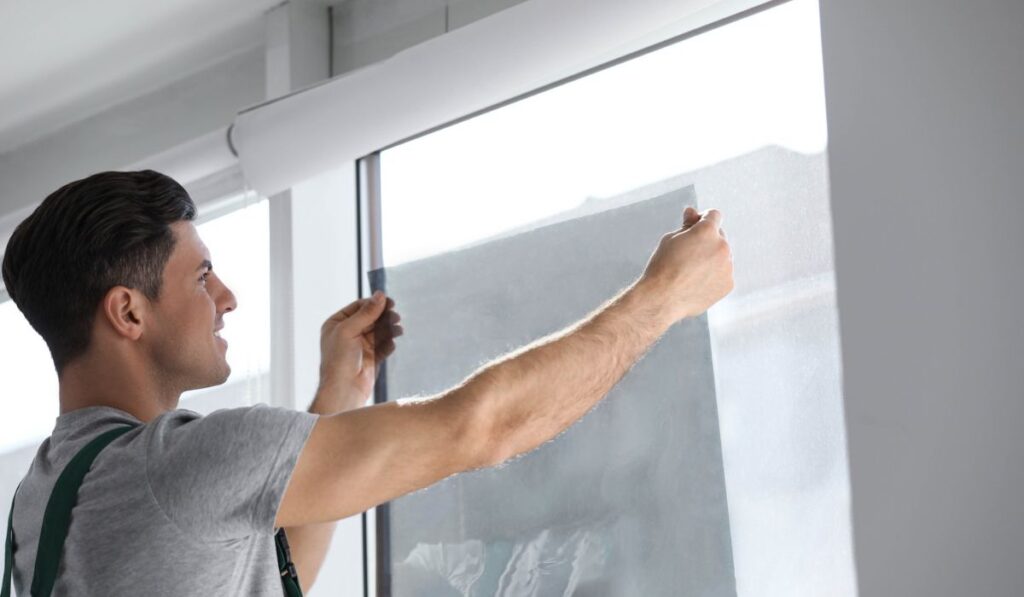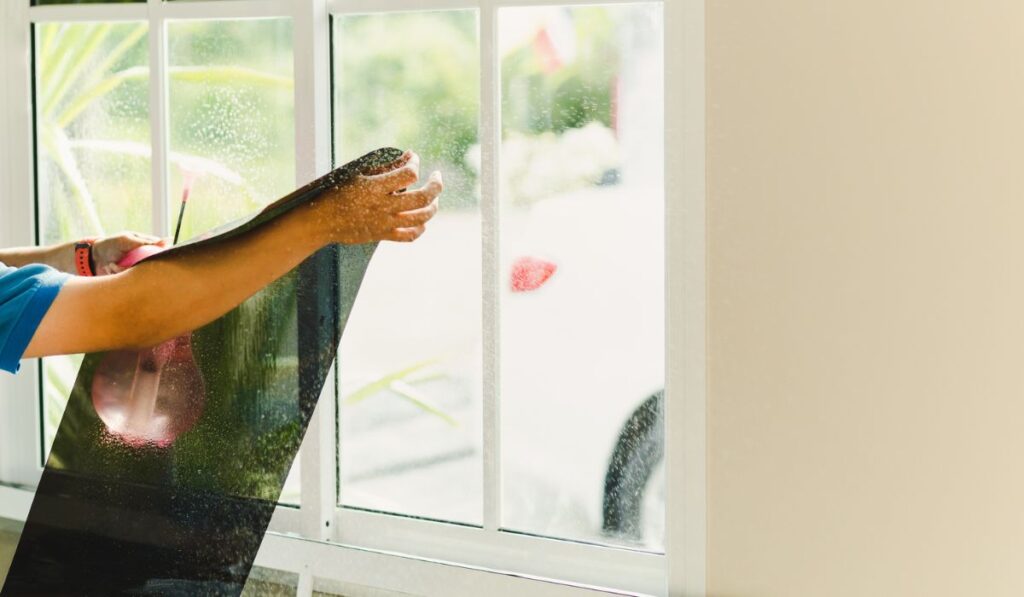Window tinting has become a popular practice because of the many benefits it can offer. Not only does it provide more privacy, but it protects objects inside the home from UV lights that may wear them down, and shields possessions from burglars being tempted to break in. So how does window tinting actually work, and is it worth paying for?
Window tinting works by placing a thin film coated with layers of dyes or metal particles on a window. This then provides a dark filter which protects the inside of a home or car from UV rays and increased security and privacy. For these benefits, many people feel the price is very worth it.
Let’s take a closer look at what window tint is made out of, as well as the benefits of tinting your windows, how long it lasts, and whether or not you can do it yourself.
What is Window Tint Made Out Of?

Window tint is typically made from a thin film made of polyester, which is then coated with layers of dyes and/or metal particles. The exact composition of the tint film can vary depending on the manufacturer and the specific type of tint. There are a few different types of window tint.
Dyed Window Tint
Dyed window tint films are made by impregnating the polyester film with a dye that absorbs solar energy, which reduces the amount of heat and light that enters through the window. The dye absorbs the remaining solar energy and releases it as heat, which is then dissipated into the air.
This type of window tint is generally less expensive than other types, but it may not be as effective at reducing heat and glare. This is what you may see most commonly in homes and cars.
Metalized Window Tint
Metalized window tint films are made by depositing a layer of metal particles onto the polyester film, which reflects solar energy away from the window. This type of window tint is more effective at reducing heat and glare than dyed films, but it can interfere with radio and GPS signals.
Ceramic Window Tint
Ceramic window tint films are made by embedding ceramic particles into the polyester film. This type of window tint is highly effective at blocking solar heat and UV rays while maintaining good visibility and clarity. It is also less likely to interfere with electronic signals than metalized films.
What is the Process of Window Tinting?
The first step in window tinting is to clean the windows thoroughly, both inside and outside, to remove any dirt, debris, or residue. This makes sure that the tint film adheres properly to the glass. Once the windows are clean and dry, the tint film is cut to the appropriate size for each window.
The tint film is then applied to the inside of the window using a solution of water and soap. The film is carefully aligned with the edges of the window and smoothed out to remove any air bubbles or wrinkles. A squeegee is used to push out any excess solution and ensure a tight bond between the film and the glass.
After the film is applied, any excess material is trimmed away from the edges of the window using a sharp blade. It then needs to dry and cure for a period of time. This allows the adhesive to bond fully to the glass and ensures that the tint film will not peel or bubble over time.
What Are the Benefits of Tinted Windows?
There are a few benefits of tinted windows, including the following.
Reduced Heat and Glare
Tinted windows can block up to 99% of the sun’s harmful UV rays and reduce heat and glare, making the interior of your vehicle or building more comfortable.
Tinted windows can protect the interior of your vehicle or building from fading and damage caused by UV rays. It can also prevent cracking and warping of upholstery and other materials.
Increased Security and Privacy
Tinted windows can increase privacy by reducing the visibility from the outside. It can also provide added security by making it more difficult for potential intruders to see inside.
Energy Saving
Tinted windows can help to reduce the amount of energy needed to cool your vehicle or building, which can result in lower energy bills and reduce your carbon footprint.
Nice Aesthetic
Tinted windows can give your vehicle or building a sleek, stylish appearance which appeals to many people.
Increased Resale Value
Lastly, tinting your windows may increase the resale value of your home or car. If you plan on selling the home or car down the line, this is an added bonus, though if you plan on keeping it for the next 10 years at least, this may not matter.
How Long Does Window Tint Last?
If your window tint is high quality, it can last up to 10 years or even more. However, lower quality window tint may start to peel and fade after just a few years.
As well as the quality of the window tint, other things that may affect the lifespan include:
- The installation method
- The environmental conditions
- How well they’re maintained
All of these factors can contribute to either a shorter or longer lifespan.
How to Maintain Window Tint
To maintain window tint, you should make sure you clean your windows very carefully. Never use a harsh or abrasive cleaner or materials, as this can drastically reduce the lifespan of the tint.
If you can, find a specialized cleaner, as this will do a much better job at keeping your windows clean while allowing the tint to last.
Can You Tint Windows Yourself?

If you have experience with DIY projects and are comfortable working with tools, you might be able to install window tint yourself with the right tools and instructions.
However, you should still do your research, and should keep in mind that many types of tint films are difficult to work with and may require special tools and techniques.
If you decide to install window tint yourself, it’s important to choose a high-quality tint film and follow the manufacturer’s instructions carefully. It’s also a good idea to practice on a small, less visible window before going for the larger windows, as you may make some mistakes the first time you can then correct.
Keep in mind that improper installation of window tint can result in problems such as bubbles, peeling, and reduced visibility. In addition, if you damage the window or the tint film during the installation process, you may end up spending more money to repair or replace it than you would have if you had hired a professional installer.
That means that, for most people, it’s a much better idea to find a professional installer. This way you know the price upfront and shouldn’t have to account for any mistakes that happen throughout the process. Make sure you check out the installer’s reviews and references, as well as ensuring they are licensed and reviews.
Overall though, many people do find the process of window tinting very worth it. While it can be a little costly, it’s an investment that can last up to 10 years if done right and taken care of properly, and it has many benefits.
